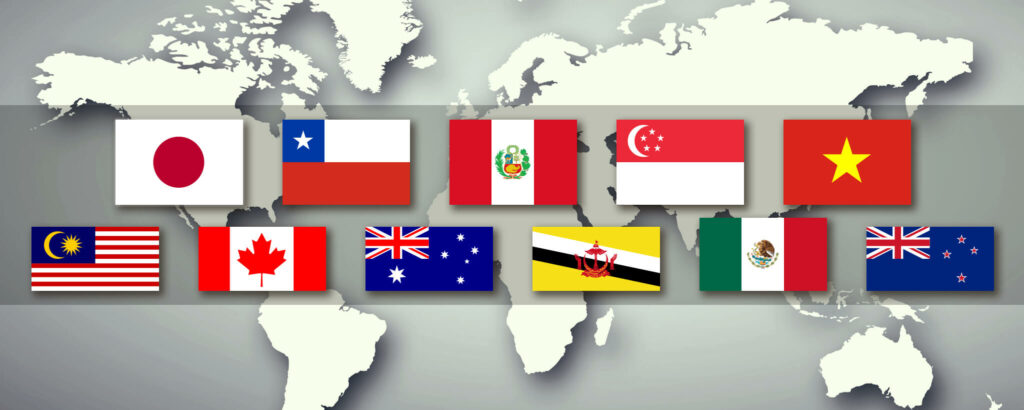Geopolitics Report – USMCA & CPTPP Scope, Stability, Success, and Risks

Geopolitics Report – USMCA & CPTPP Scope, Stability, Success, and Risks
I. Purpose of the Report
This report, prepared for Lululemon Athletica (Lululemon) considering the company’s business and athletic apparel industry, aims to provide understanding and assessment of the two supranational trade agreements: United States–Mexico–Canada Agreement (USMCA), and Comprehensive and Progressive Agreement for Trans-Pacific Partnership (CPTPP).
This paper discusses the stability, success, and risks of each agreement generally, and argues the possible opportunities and benefits that each agreement may bring for the company. We, Special Projects Team, have started with a brief analysis of our company’s business, and athletic apparel industry that the company engages in, and concluded the report with our recommendations to the management.
II. Identification of company and industry chosen
Lululemon is a Vancouver-based company founded in 1988 by Chip Wilson a Canadian billionaire, businessman, and philanthropist. The company is known for being a high-end athletic apparel company that mainly focuses its image on Yoga. Some of Lululemon’s typical products are fitness pants, shorts, tops, and jackets for yoga, dance, and casual sportswear for both men and women. In the last couple of years, Lululemon has not only grown rapidly domestically but also expanded its operations to other international markets such as The United States, China, or Japan. By 2020, Lululemon has approximately 500 stores globally (Lululemon, 2020).
About the industry, apparel can technically be categorized as clothing and the apparel industry focuses on making and selling ready-to-wear clothing, which is defined as mass-produced personal outfits, garments such as underwear, headwear, casual sportswear and other intimate kinds of clothing. In the past, apparel companies were typically wholesalers who manufacture and sell large quantities of clothing to their distributors, also known as retailers. Then those retailers sell to the end-consumers at marked-up prices for profits. However, in the modern industry, most brands tend to do both types of businesses from designing to manufacturing to commercializing. The reason is that having stores and online platforms dedicated to one specific brand give a company the necessary control over its brand identity and more profits. Another reason worth mentioning is that the nature of apparel sales is highly seasonal and trend-based. These factors are valuable for brands like Lululemon to determine if they could reach higher sales in a certain period of the year to cover the losses during other off-season periods (Value Line, nd).
In terms of international export, North America and Asia can be considered as high-potential markets that Lululemon could go for. Thus, it is important for the company to have a proper understanding of the two trade agreements for these regions: United States–Mexico–Canada Agreement (USMCA), and Comprehensive and Progressive Agreement for Trans-Pacific Partnership (CPTPP). These agreements could help to assess both opportunities and risks of entering the markets of countries belonging to the agreements.
III. USMCA scope, stability, success, and risks
USMCA is the free trade agreement signed by the US, Canada, and Mexico and went into effect on July 1, 2020. Before USMCA, there was the North American Free Trade Agreement (NAFTA) dated 1994 between these three countries which allowed the creation of the largest free-trade region in the world. The US President, Donald Trump, called NAFTA “the worst deal in the US history,” and ‘’a nightmare’’ which pushed the countries to renegotiate and agree on a refined version (Kirby, 2020). Following the signing of the USMCA, the Office of the US Trade Representative described the new agreement as a “more balanced and reciprocal trade’’ (2020).
Major changes from NAFTA to USMCA include new provisions on labor and environmental standards, IP protections, cars, and automobile industry, and digital trade. There are not many changes that specifically touch on the manufacturing or apparel industry in which Lululemon is engaged.
USMCA restates tariff-free market access for the signatory countries which was established by NAFTA but introduced new clauses to address certain challenges that, allegedly, NAFTA has been a failure to deal with. It is important to note that such challenges were the problems identified by the US, not Canada. The main reason was that the US wanted to lower the trade deficit between the US and Mexico.
Nevertheless, USMCA will play a big role for the exporters and importers in all three countries to boost their international sales. Brought in to promote trading relationships and address 21st-century trade issues, this new NAFTA encourages more business opportunities between the three long-time trade partners (The Council of Canadians, 2019). It secures the countries’ bilateral relations and cooperation in various industries, including the manufacturing and apparel industry. It also aims to address the rise of e-commerce by expediting e-commerce exports through enhanced regulations (Kirby, 2020).
In the same way as NAFTA, USMCA allows the three partners to create a powerful regional bloc competing against their Europe and East Asia counterparts. While Mexico will continue to enjoy the perks of low-cost manufacturing deals, Canada and the US businesses will continue to enjoy less paperwork and customs duties in borders.
Apart from its benefits, USMCA brings some risks and challenges for Canada. The main risk for our country with any trade agreement with the US is to make ourselves dependent on the US market. Canada’s 76% of exports are with the US while the US has only 18% of its exports with Canada. If the political relationship between the US and Canadian governments deteriorates for any reason, impacts on Canadian exporters and businesses will be way higher than their US partners. It brings an increased risk of the US using our vulnerability as a pressure point as we are dependent on the U.S. more than the US is on us (Crowley, 2019).
Further, USMCA is blamed for the free flow of Canadians’ data to the US. There is a clause in the agreement that reads “No Party shall prohibit or restrict the cross-border transfer of information, including personal information, for business purposes”. Considering Canada’s three fourth of trade is with the US, some Canadian data experts criticize this agreement to not only free trade but also frees Canada’s data including Canadians’ personal information. Some even claim that this so-called modernized NAFTA undermines Canadian sovereignty (Ross, 2018).
As a company that has a huge potential and good fame in the athletic apparel industry, and already keeps up with a good upward trend, Lululemon can benefit from this agreement to expand its presence in Mexico. As of July 2020, we have only 2 stores, and 1 showroom in Mexico whereas we have more than 300 stores in the US. Mexico is the second closest country (by land) for us, but while 16% of the US’ exports go to Mexico, only 1.2% of Canada’s exports go to Mexico (Trading Economics (Ed.), 2020). Nonetheless, Mexico is the third-largest merchandise trading partner for Canada (Government of Canada (Ed.), 2018).
As well as our country, our company can utilize Mexico’s market potential too. The country has a massive youth potential as the median age in Mexico is below 30 years (exactly 27 years). More specifically, almost 70% of the population is between 15 and 64 years old, 25% of the population is below 14 years old (Statista (Ed.), 2020).
Unless another president of any of the signatory countries declares this new agreement is “the worst deal ever”, and devote to rips it up again, the stability of the USMCA seems promising. We expect this reboot of NAFTA to be in force for long years.
IV. CPTPP scope, stability, success, and risks
According to the Government of Canada (2020), “The Comprehensive and Progressive Agreement for Trans-Pacific Partnership (CPTPP) is a free trade agreement between Canada and 10 other countries in the Asia-Pacific region: Australia, Brunei, Chile, Japan, Malaysia, Mexico, New Zealand, Peru, Singapore, and Vietnam”. Immediately following implementation CPTPP, the named countries will have opportunities to gain access to approximately 495 million shoppers or customers along with global GDP of 13.5%, giving Canadian businesses privileged entrance to major markets segments in Latin America and Asia. On December 30, 2018, CPTPP endorsed the agreement with Japan, Canada, Singapore, Australia, New Zealand, and Mexico; on the 14th of January 2019 endorsed Vietnam.
The CPTPP free trade agreement is a very comprehensive arrangement that includes market entry for commodities, services, investments, and government purchases which normally produces the greatest ecological impacts. The Government of Canada (2018), states that the CPTPP agreement comprises of rules surrounding fields or areas of “intellectual property (IP), e-commerce, and technical barriers to trade (TBT)”. It brings benefits to many different sectors across the Canadian economy, namely forestry, financial services, metals and minerals, agriculture, energy products, fish and seafood, and a variety of industrialized manufactured goods. One of the main aims of this agreement is to safeguard Canada’s economic prosperity in a developing and accountable way (Government of Canada, 2018).
With almost one (1) year after the agreement has been signed and implemented, CPTPP has generated mixed advantages to the 11 countries or signatories. The flow of trade between some of those countries has boomed while others remained steady. As for Canada, a more reasonable increase has been experienced by exporters. Especially for Ottawa who recognized moderate export growth with approximately 1% trading with all 11 CPTPP partnering countries. There is the potential that CPTPP will see a better increase over the long-term period. It is however very hard to state exactly the level of influence this trade agreement had over the past year. Regardless of the past year, CPTPP holds the capability to improve the country’s international revenue by $147 billion per annum (Corporal, 2019), but it may well take a while for this to take place. The CPTPP has lots of expansion opportunities, for the countries involved as well as new interesting countries.
The eleven (11) countries taking part in the CPTPP created one of the biggest trading regions worldwide. According to the Government of Canada (2020) Canada’s consensual trade agreement with “Australia, Brunei Darussalam, Japan, Malaysia, New Zealand, Singapore, and Vietnam” averaged approximately $71.3 billion in 2016. Canadian corporations will at once have better entry into international markets, even more than the U.S.A business rivals. This enabled Canadian businesses and exporters to secure greater market shares within these nations. The Global Affairs Canada Chief Economist Office analyzed the economy and they concluded Canada would be able to receive an economic revenue approximately 4.2 billion dollars from the CPTPP agreement over an extended period. These future revenues will be made possible through the increase in the exporting of goods and services and an increase in international investments. They also predict the CPTPP agreement will be able to bring benefits to all provinces across Canada.
Additionally, CPTPP has generated new opportunities for businesses to fast-track their various textile-garment international shipments to new markets. Companies that trade under CPTPP can do so with confidence as the agreement ensures that those companies are protected from any biased and unfair treatment, along with greater transparency and certainty. Because many of the provisions under TPP remains with CPTPP, 95% of goods traded including apparels and textiles will see customs duty will be removed, which implies that Lululemon would be able to trade internationally with low costs.
For e-commerce, there is the risk that CPTPP will largely refuse any kind of data localization as well as electronically transmitted information for customs duties (Corporal, 2019). He also stated that this free trade agreement comes with a certain environmental commitment that must be made, it also stipulates that there are international labor laws that must be accepted and agreed upon. There is also the fact that the benefits mentioned previously will vary from one nation to another.
V. Recommendations to management
Firstly, we recommend Lululemon to take advantage of the benefits of the new trade agreement between the United States, Mexico, and Canada (USMCA), such as free tariffs and less paperwork to expand its Market into Mexico. Also, Mexico is the second closest country to Canada, and its demographic factor shows enormous market potential. For example, the average age of Mexico is 27 years, which represents a young population and a great opportunity for Lululemon to reach out to its targeted customers. (Statista, 2020).
Second, we suggest Lululemon to exploit the advantages of the Global and Progressive Agreement for the Trans-Pacific Association (CPTPP). For example, the company can consider focusing on Singapore, a member of CPTPP. This country is one of the fastest growing and most dynamic markets in the world. The CPTPP benefits Lululemon Athletica’s exports to Singapore by eliminating tariff rates on most products exported from Canada, including textile products marketed by the company. Moreover, this agreement allows Canadian companies to export to Singapore with great security, confidence, transparency, and fair politic treatments.
Lastly, Canada has a close relationship with The United States when it comes to importing or exporting goods. However, there is an obvious risk come from being heavily reliant on one market. Therefore, it is in Canada’s interest to seek out for new markets in other geographic regions to minimize that risk. And the two agreements could be the keys to open doors to other prosper and innovative markets
VI. Conclusion
In a nutshell, Lululemon, a Vancouver-based high-end athletic apparel company, has a lot of business expansion opportunities in other countries like Mexico and Singapore because of Canada’s free trade agreements, which are Comprehensive and Progressive Agreement for Trans-Pacific Partnership (CPTPP) and United-States-Mexico-Canda Agreement (USMCA).
As a retail company located in Canada, it would be easier for Lululemon to enter in Mexico because of the USMCA. As the objective of this free trade agreement is to boost international relations for exporters and importers among the participating countries: the US, Canada, and Mexico. As Mexico is the 3rd largest merchandise trading partner of Canada, it would also be safer for Lululemon to export in Mexico because of the country’s positive commitment to bilateral relations and cooperation in the apparel industry. Importantly, Mexico’s population is between 15-64 years old, while 25% is below 14 years old. This pertains that the median age is around 27-30 years old, which is the target market of Lululemon.
On the other hand, Singapore is a potential business expansion location of Lululemon because of the benefits of the CPTPP. This free trade agreement is between Canada and among Asia-Pacific Region. It would be a good opportunity for Lululemon to expand in Singapore because under the CPTPP will generate more opportunities for business in fast-tracking various textile-garment international shipments. Thus, exporting Lululemon athletic apparel would be faster to be shipped in Singapore. However, there would be a risk of e-Commerce in Canada, because CPTPP declines any kind of data localization and electronically transmitted information for customs duties. Lastly, Singapore is a wealthy country despite a small population, who are the target buyers of Lululemon because of its high-priced athletic wear.
Like Lululemon, companies must take into consideration the international relations of Canada with other countries before exporting or importing products. Every country has different trade agreements that must be studied and analyzed. Also, to successfully expand a Canadian business globally, the firm must do international market research including its government regulatory requirements.





